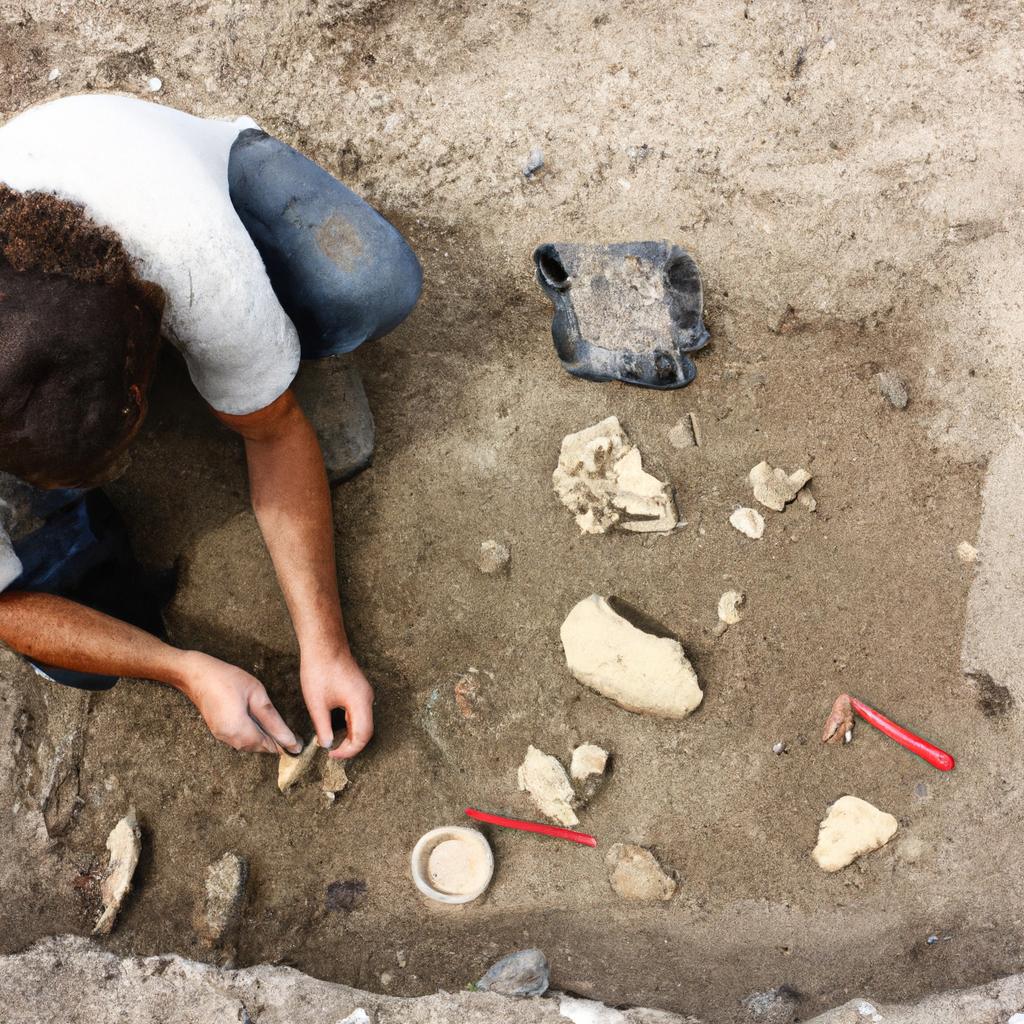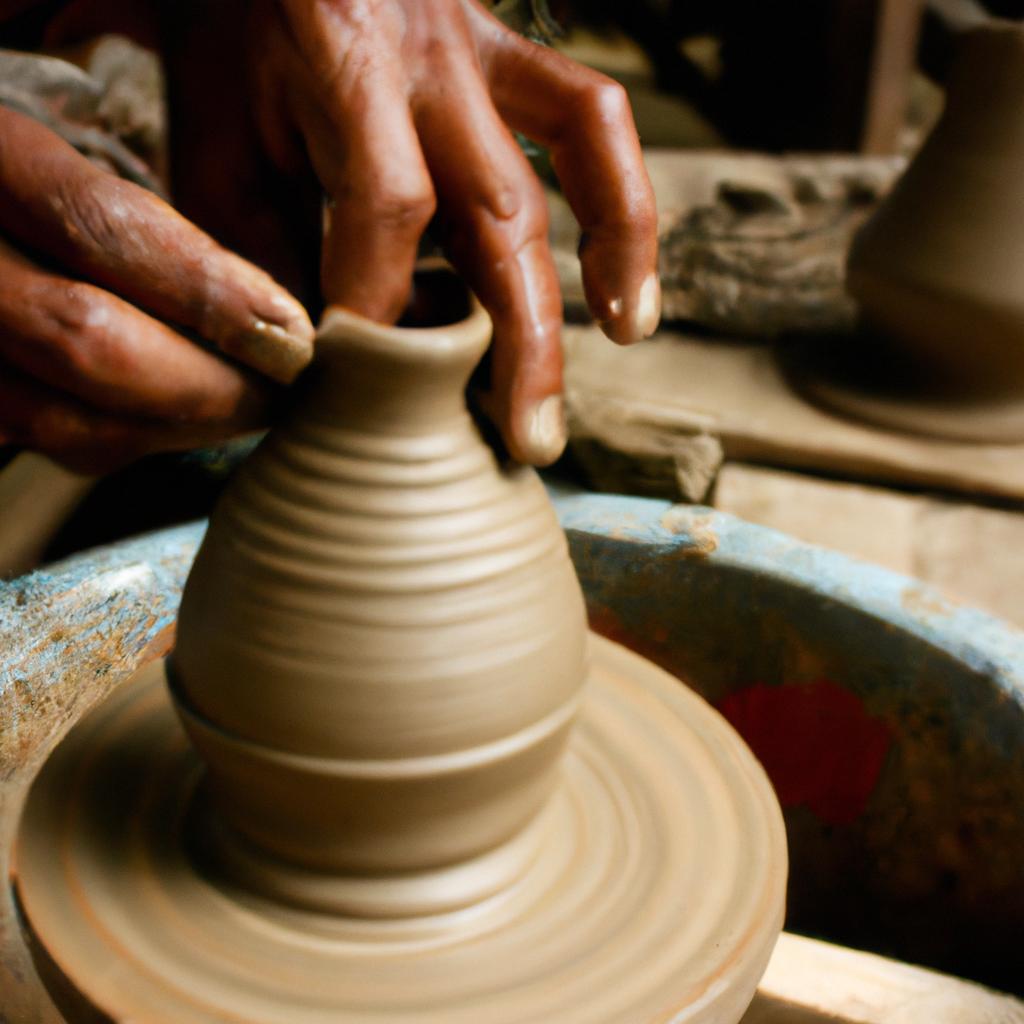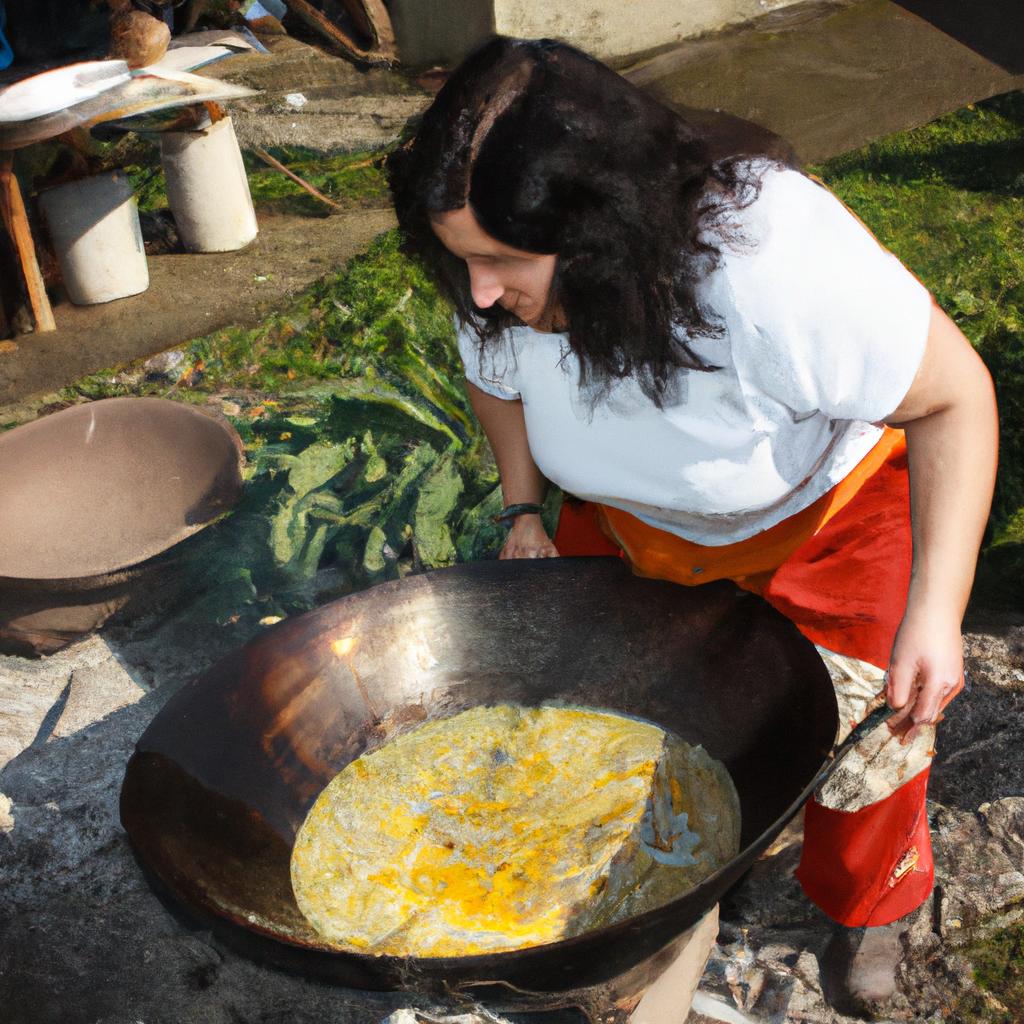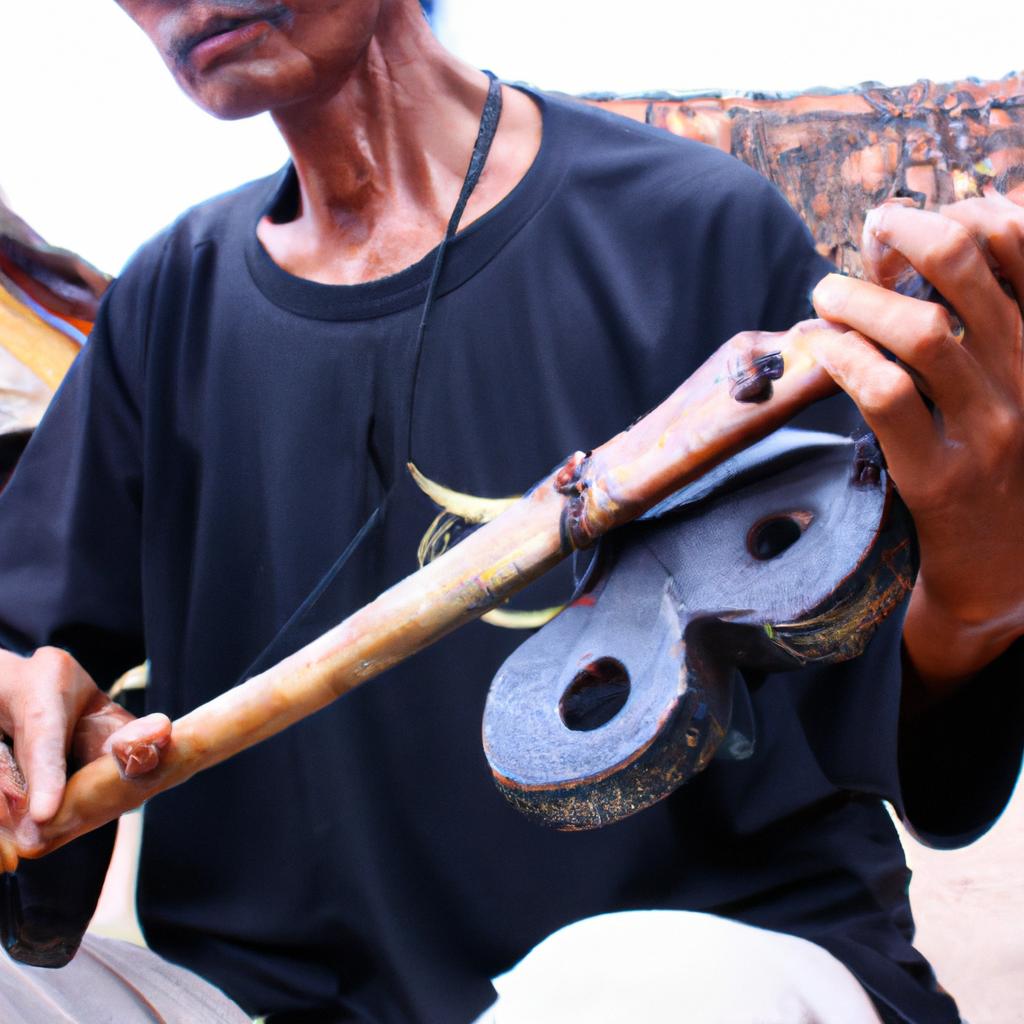Local handicrafts play a significant role in enhancing cultural experiences for tourists seeking rural accommodations. In the picturesque region of Cangas de Onas, nestled amidst the breathtaking landscapes of northern Spain, traditional craftsmanship thrives as an integral part of the local culture. This article explores how the incorporation of local handicrafts into rural accommodation establishments can enrich visitors’ understanding and appreciation of the region’s heritage.
To illustrate this point, let us consider a hypothetical scenario where a family from Germany decides to spend their vacation in Cangas de Onas. They opt to stay at a charming guesthouse that showcases various handicrafts created by local artisans. Upon arrival, they are immediately captivated by intricate pottery pieces adorning the reception area and vibrant textiles embellishing the walls. Curiosity piqued, they engage with staff members who proudly share stories behind each crafted item, shedding light on its historical significance and cultural relevance within the community. As days pass, our German guests not only enjoy comfortable lodging but also immerse themselves in interactive workshops led by skilled craftsmen who patiently impart their knowledge and expertise. By actively participating in these activities, individuals gain firsthand experience in creating unique crafts while forging connections with the local artisans, fostering cross-cultural exchange and mutual appreciation of craftsmanship.
During their stay, the German family discovers that the guesthouse also organizes visits to nearby artisan workshops and markets. Eager to explore further, they embark on a guided tour of a pottery workshop, where they witness the meticulous process of transforming raw clay into exquisite earthenware. The artisans explain the techniques passed down through generations and happily answer questions posed by our curious guests. This immersive experience allows the family to grasp not only the technical aspects but also the passion and dedication required to produce such beautiful handicrafts.
As our German visitors continue their exploration of Cangas de Onas, they encounter local markets bustling with activity. Here, they discover a wide array of handmade products – from intricately woven baskets to delicately embroidered textiles – each reflecting the region’s unique cultural heritage. By interacting with stall owners and artisans at these markets, our tourists gain insight into traditional techniques, materials used, and even regional variations in styles.
The incorporation of local handicrafts into rural accommodations not only enhances tourism experiences but also contributes significantly to sustainable development within communities like Cangas de Onas. By supporting local artisans and promoting their crafts, rural establishments create economic opportunities for individuals who might otherwise struggle to sustain traditional practices in an increasingly modernized world. Moreover, this symbiotic relationship between tourism and craft preservation ensures that future generations can inherit and appreciate these invaluable traditions.
In conclusion, integrating local handicrafts into rural accommodations provides visitors with an unparalleled opportunity to engage with the culture and heritage of a destination like Cangas de Onas. Through interactive workshops, guided tours, and visits to artisan markets, tourists can deepen their understanding and appreciation of traditional craftsmanship while fostering connections with local communities. This mutually beneficial relationship between tourism and craft preservation paves the way for sustainable development while enriching travelers’ cultural experiences.
History of Handicrafts in Cangas de Onas
One notable example that showcases the rich history of handicrafts in Cangas de Onas is the case of Teresa García, a skilled weaver who has been practicing her craft for over four decades. Her intricate tapestries and vibrant textiles have garnered recognition both locally and internationally, making her an emblematic figure within the local handicraft community.
The tradition of handicrafts in Cangas de Onas dates back centuries, with its roots deeply embedded in the region’s cultural heritage. Passed down from one generation to another, these traditional crafts represent not only artistic expression but also a way for local communities to preserve their customs and identity. The artistry involved in creating these handmade products reflects the ingenuity and skill honed by artisans over time.
To fully appreciate the significance of handicrafts in Cangas de Onas, it is important to acknowledge their multifaceted impact on various aspects of society. Firstly, they contribute to the economic growth of rural areas by providing sustainable livelihood opportunities for local artisans. This allows them to continue practicing their traditional trades while ensuring economic sustainability for themselves and their families.
Moreover, handicrafts play a crucial role in enhancing tourism experiences in rural accommodations within Cangas de Onas. Visitors are drawn to the authentic charm and uniqueness offered by locally crafted goods, appreciating the opportunity to purchase items that reflect both the cultural heritage and individuality of this picturesque town. By engaging with these crafts firsthand, tourists can develop a deeper connection with the place they are visiting and gain a better understanding of its traditions.
In summary, handicrafts hold great historical value as they embody centuries-old practices passed down through generations. They provide not only economic benefits but also serve as a means to connect visitors with local culture and traditions. In the following section about “Traditional Techniques and Artistry,” we will explore further how these crafts are created, showcasing the mastery and expertise behind their production.
Traditional Techniques and Artistry
Local Handicrafts: Enhancing Cultural Experiences in Rural Accommodation in Cangas de Onas
History of Handicrafts in Cangas de Onas has provided valuable insights into the origins and evolution of traditional techniques and artistry. Building upon this foundation, the following section explores the ways in which these handicrafts contribute to enhancing cultural experiences for visitors staying in rural accommodations.
To illustrate the impact of local handicrafts on cultural experiences, let us consider a hypothetical scenario where a group of tourists arrives at a quaint Bed and Breakfast nestled amidst the picturesque landscapes of Cangas de Onas. Upon checking-in, they are greeted by handcrafted pottery pieces adorning the reception area, showcasing intricate designs that reflect regional aesthetics. This initial encounter not only sets the tone for their stay but also piques their interest in exploring more about the rich heritage of local crafts.
The incorporation of local handicrafts within rural accommodations can greatly enhance visitors’ cultural experiences by:
- Promoting authenticity: By showcasing locally made items such as woven textiles or carved wooden artifacts, guests are exposed to genuine representations of regional culture and traditions.
- Encouraging interaction: The presence of workshops or demonstrations led by skilled artisans provides opportunities for guests to engage directly with craft-makers, fostering a deeper understanding and appreciation for their work.
- Supporting sustainable practices: When visitors purchase handmade products created using eco-friendly materials and methods, they actively contribute to preserving traditional craftsmanship while promoting sustainability.
- Creating memorable souvenirs: Guests often seek unique mementos to commemorate their travels. Local handicrafts offer an array of distinctive options that embody both artistic excellence and cultural significance.
Table 1 illustrates how different types of local handicrafts enrich cultural experiences for tourists visiting Cangas de Onas:
| Type | Description | Emotional Impact |
|---|---|---|
| Pottery | Handcrafted ceramics showcasing local motifs | Aesthetic pleasure |
| Textiles | Woven fabrics reflecting traditional patterns | Sense of heritage |
| Woodcarving | Intricate wooden sculptures | Appreciation for skill |
| Basketry | Artisanal baskets made from natural materials | Connection to nature |
In summary, the incorporation of local handicrafts in rural accommodations enhances cultural experiences by promoting authenticity, encouraging interaction with artisans, supporting sustainable practices, and providing memorable souvenirs. By immersing guests in the region’s rich artistic heritage, these craft traditions contribute to a deeper appreciation of Cangas de Onas’ cultural identity.
The impact of handicrafts on the local economy will now be examined, exploring how these creative endeavors stimulate economic growth and empower communities.
Impact of Handicrafts on Local Economy
Enhancing Cultural Experiences through Local Handicrafts
This section will explore how these unique crafts contribute to the overall tourism experience by immersing travelers in the rich heritage of the region.
One compelling example is the weaving workshops offered at Casa Rural Artesanía. Here, guests have the opportunity to learn from skilled artisans who preserve ancient textile traditions passed down through generations. By actively participating in the creation process, visitors not only gain insight into historical techniques but also create their own personal connection with the craft. Such hands-on experiences foster a deeper appreciation for the artistic skills involved and offer an emotional bond that extends beyond mere observation.
To further illustrate the impact of local handicrafts on cultural immersion, consider the following bullet points:
- The tactile nature of working with raw materials allows tourists to engage all their senses, creating lasting memories.
- Participating in workshops fosters cross-cultural exchange between tourists and local craftsmen.
- Supporting local artisans helps to ensure the preservation of traditional skills for future generations.
- Purchasing handmade products directly supports sustainable livelihoods within rural communities.
Additionally, a table showcasing various aspects related to local handicrafts can evoke an emotional response among readers:
| Aspect | Benefits |
|---|---|
| Skill preservation | Safeguarding intangible cultural heritage |
| Economic empowerment | Fostering economic growth within communities |
| Social cohesion | Strengthening community ties |
| Sustainable tourism | Promoting environmentally friendly practices |
In conclusion, local handicrafts significantly enhance cultural experiences for visitors to Cangas de Onas. Through active participation and engagement with skilled artisans, tourists forge connections with both tradition and culture. Furthermore, supporting local craftsmanship contributes to the preservation of heritage and traditional skills, creating a sustainable cycle that benefits both tourists and local communities.
Transitioning into the subsequent section on “Preserving Heritage and Traditional Skills,” it is crucial to recognize the pivotal role played by rural accommodations in Cangas de Onas. These establishments serve as gateways for travelers seeking an authentic cultural experience while also contributing to the conservation of intangible heritage.
Preserving Heritage and Traditional Skills
Impact of Handicrafts on Local Economy (Continued)
The impact of handicrafts extends beyond the local economy, contributing significantly to the preservation of heritage and traditional skills. By engaging with these crafts, tourists not only gain a deeper understanding of the local culture but also actively participate in its conservation.
For instance, let us consider the case study of Maria, a traveler who decides to stay at a rural accommodation in Cangas de Onas. During her visit, Maria takes part in a pottery workshop offered by a local artisan. Through this experience, she learns about the intricate process behind creating traditional ceramics specific to the region. This hands-on activity immerses Maria into the cultural fabric of Cangas de Onas while simultaneously supporting local artisans and their craft.
To further emphasize the importance of preserving heritage and traditional skills through handicrafts, we present four key points:
- Cultural Heritage: Handicrafts serve as tangible links between past generations and present communities, ensuring that cultural traditions are passed down from one generation to another.
- Socioeconomic Development: The promotion and sale of locally made handicrafts contribute directly to sustainable economic growth within rural areas. It provides income opportunities for artisans and stimulates entrepreneurship among locals.
- Tourist Attraction: Unique handicrafts have an inherent appeal for travelers seeking authentic experiences. They add value to tourism offerings by providing visitors with memorable encounters rooted in heritage and tradition.
- Environmental Sustainability: Many handicraft techniques utilize natural materials sourced sustainably from surrounding environments. This promotes eco-friendly practices while encouraging consciousness about resource utilization.
To illustrate how different aspects interconnect within this context, below is a three-column table highlighting various components related to the impact of handicrafts on local economies and cultural preservation:
| Components | Impact | Examples |
|---|---|---|
| Economic Development | Increased revenue and employment | Higher income for artisans |
| Cultural Preservation | Safeguarding traditions | Passed down craft techniques |
| Tourism Enhancement | Attracting cultural enthusiasts | Tourists engaging in local workshops |
| Environmental Sustainability | Promoting eco-friendly practices | Use of sustainable materials |
In conclusion, the preservation of heritage and traditional skills through handicrafts not only contributes to the local economy but also enriches cultural experiences for both tourists and locals. By actively participating in these crafts, visitors gain a deeper appreciation for the region’s culture while supporting its sustainability.
Transitioning into the subsequent section about “Exploring Unique Handicrafts in Cangas de Onas,” we continue our exploration of the diverse range of crafts available within this charming rural destination.
Exploring Unique Handicrafts in Cangas de Onas
As we delve deeper into the rich cultural heritage of Cangas de Onas, it becomes evident that the preservation of traditional skills is not only about safeguarding the past but also enhancing the present experiences for visitors. One notable example is the local production of handcrafted ceramics, which continues to thrive in this region despite modernization and globalization. This section will shed light on some unique handicrafts found in Cangas de Onas, showcasing their significance in enhancing cultural experiences within rural accommodations.
Among the diverse range of handicrafts available, woodcarving stands out as a prominent art form deeply rooted in local traditions. The intricate designs and craftsmanship displayed by artisans captivate visitors, offering them an immersive journey into the history and culture of this enchanting destination. For instance, Casa Rural El Bosque has collaborated with skilled woodcarvers from the surrounding villages to create custom-made furniture pieces exclusively for their accommodation. This collaboration not only supports local artisans but also provides guests with authentic and visually appealing furnishings that reflect the essence of Cangas de Onas.
To further enhance cultural experiences, many rural accommodations in Cangas de Onas curate exhibitions or organize workshops where guests can actively engage with these crafts. Such initiatives enable travelers to gain firsthand knowledge about different techniques involved in creating various handicrafts. By participating in these activities, tourists not only learn new skills but also develop a profound appreciation for the dedication and talent required to produce these remarkable works of art.
The impact of exploring unique handicrafts within rural accommodations goes beyond mere aesthetic appreciation; it fosters a sense of connection between visitors and the local community. To illustrate this point effectively, consider the following emotional bullet points:
- Experiencing the therapeutic benefits of engaging in hands-on craftwork.
- Immersing oneself in centuries-old artistic traditions passed down through generations.
- Appreciating the intricate details and cultural symbolism embedded in each handmade piece.
- Supporting local artisans, their families, and the sustainability of traditional crafts.
Moreover, to provide a visual representation of the diverse handicrafts found in Cangas de Onas, here is a table showcasing some notable examples:
| Handicraft | Description | Significance |
|---|---|---|
| Ceramics | Beautifully hand-painted pottery | Reflects regional motifs |
| Textiles | Intricate weaving techniques | Preserves ancient textile traditions |
| Basketry | Skillful creation of baskets from natural materials | Showcases sustainable practices |
| Leatherwork | Exquisite craftsmanship on leather products | Highlights artistic versatility |
By embracing these unique handicrafts within rural accommodations, tourists not only contribute to the preservation of cultural heritage but also support local artisans and promote sustainable tourism. In the subsequent section about “Supporting Local Artisans and Sustainable Tourism,” we will delve deeper into how these initiatives can create a positive impact on both visitors and host communities alike.
Supporting Local Artisans and Sustainable Tourism
Now, let us explore how these local handicrafts can enhance cultural experiences for visitors staying in rural accommodations within this charming region.
Imagine a traveler arriving at a rustic bed and breakfast nestled amidst the picturesque landscapes of Cangas de Onas. As they settle into their cozy room, adorned with traditional handwoven tapestries and ceramics crafted by local artisans, they are immediately immersed in the essence of the region’s heritage. This initial encounter sets the stage for an authentic cultural experience that extends beyond mere accommodation.
To further illustrate the impact of local handicrafts on enhancing cultural experiences, consider the following:
- The presence of handmade wooden furniture, intricately carved with motifs inspired by Asturian folklore, allows guests to appreciate not just the aesthetic beauty but also gain insights into the craftsmanship and tradition behind each piece.
- Traditional textile works such as delicate lace doilies or vibrant knitted blankets showcase intricate patterns passed down through generations. These artifacts enable visitors to connect with the skills and stories woven into every thread, fostering a deeper appreciation for local customs.
- Exquisite pottery bearing symbolic designs reflective of regional identity becomes more than mere decorative items; it offers visitors an opportunity to understand the symbolism embedded within these creations and fosters a sense of connection to the community’s historical roots.
- Displaying artwork created by talented painters using natural pigments derived from locally sourced materials evokes a sense of place and highlights the strong bond between artistry and nature prevalent in Cangas de Onas.
With its focus on preserving traditions while embracing sustainability, Cangas de Onas has become a hub for nurturing both skilled artisans and conscious travelers seeking meaningful encounters. By incorporating local handicrafts into rural accommodations, visitors are presented with an opportunity to engage with the region’s cultural heritage in a profound and immersive manner, thereby enriching their overall experience.
| Handcrafted Pottery | Traditional Textile Work | Wooden Furniture |
|---|---|---|
| Symbolism | Intricate Patterns | Asturian Folklore |
| Cultural Identity | Historical Significance | Craftsmanship |
| Connection | Skills | Tradition |
By intertwining local handicrafts into the fabric of rural accommodations, guests are invited to not only observe but also participate in preserving cultural traditions. This integration creates a symbiotic relationship between visitors and artisans, fostering mutual understanding and appreciation for each other’s contributions. The result is a more meaningful and authentic travel experience that transcends mere sightseeing, allowing individuals to forge lasting connections with the destination and its people.
 Casa Amparo Triana
Casa Amparo Triana



